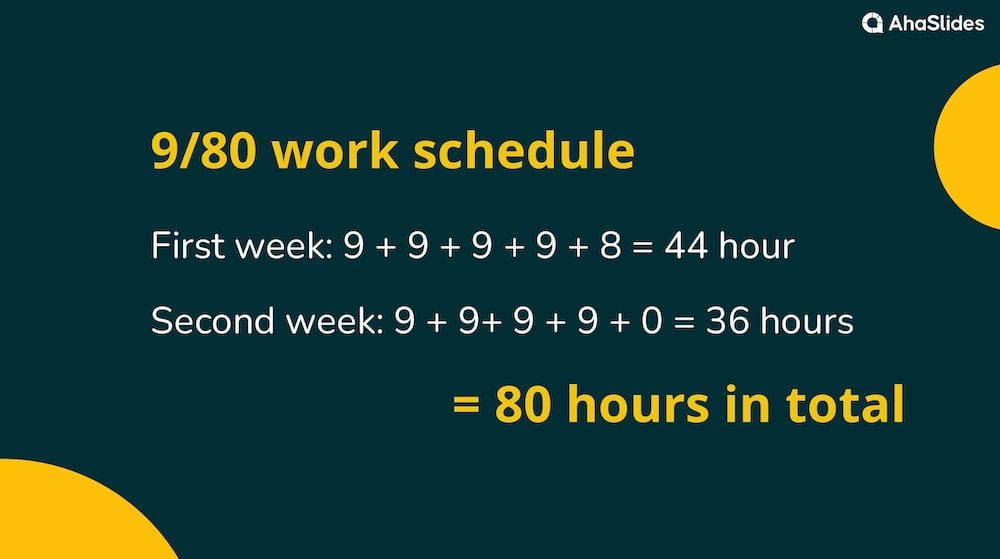Har du nogensinde følt, at den klassiske 9-5-rutine bare er for kedelig og begrænsende i disse dage? Du er ikke alene – masser af mennesker synes, det er tid til noget nyt.
Flere og flere virksomheder erkender dette, da de begynder at tilbyde alternativer til den normale 9-5-travle hverdag.
En mulighed, der vinder popularitet, er 80/9-arbejdsplanen.
Er du ikke sikker på, om det ville være et godt match for dig eller dit team? Bare rolig, vi gennemgår det hele for dig.
Vi vil forklare præcis hvordan 9-80 arbejdstid virker, fordele og ulemper for både medarbejdere og arbejdsgivere, og om det kunne passe godt til din virksomhed.
Indholdsfortegnelse
- Hvad er en 9-80 arbejdsplan?
- Hvad er et eksempel på en 80-9 arbejdsplan?
- Hvad er fordelene ved en 9-80 arbejdsplan?
- Potentielle ulemper ved en 9-80 arbejdsplan
- Nøgleforsøg
- Ofte stillede spørgsmål
Tips til bedre engagement

Leder du efter mere sjov under sammenkomster?
Saml dine teammedlemmer ved en sjov quiz på AhaSlides. Tilmeld dig for at tage gratis quiz fra AhaSlides skabelonbibliotek!
🚀 Snup gratis quiz☁️
Hvad er en 9-80 arbejdsplan?
En 9/80 arbejdsplan er et alternativ til traditionel 9-5, fem dages arbejdsuge, hvor du i stedet for at arbejde 8 timer om dagen, mandag til fredag arbejde 9 timer om dagen i en to-ugers arbejdsperiode.
Dette tilføjer op til 80 timer hver anden uge (9 dage x 9 timer = 81 timer, minus 1 times overarbejde).
Du har fri hver anden fredag som din flex dagSå den ene uge arbejder du mandag-torsdag og den næste mandag-fredag.
Dette giver dig en 3-dages weekend hver anden uge, så du effektivt får ekstra fri uden at bruge feriedage.
Din tidsplan er normalt sat op, så din flexdag falder på samme dag i hver lønperiode. Dette bevarer sammenhængen.
Tidtagning følger stadig standarden 40 timers arbejdsuge regler om overarbejdsbetaling. Alt over 8 timer på en dag eller 80 timer i en lønperiode udløser OT.

Hvad er et eksempel på en 80/9 arbejdsplan?
Her er et eksempel på, hvordan arbejdsplanen for 9/80 ser ud, med en times frokostpause hver dag:
| Uge 1 | Uge 2 |
| Mandag 8 – 00 Tirsdag 8: 00 - 6: 00 Onsdag 8 – 00 Torsdag 8 – 00 Fredag 8: 00 - 5: 00 | Mandag 8 – 00 Tirsdag 8: 00 - 6: 00 Onsdag 8 – 00 Torsdag 8 – 00 Fridag fredag |
Nogle almindelige industrier, der bruger 9-80 arbejdsplanen inkluderer:
Regeringskontorer – Føderale, statslige og lokale myndigheder tilbyder ofte 9-80 timer til deres ansatte. Ting som motorvejstjenester, posttjenester og offentlige arbejder.
Medicinal – Hospitaler ønsker dækning 7 dage om ugen, så de roterende fridage hjælper med det. Kontorpersonale som klinikker og laboratorier bruger det også.
Hjælpeprogrammer – Steder som vandbehandlingsanlæg, elselskaber osv. skal overvåges konstant, så tidsplanen forbedrer dækningen.
Manufacturing – For døgnåbne produktionsgulve hjælper 24/7 med at sikre korrekt bemanding på tværs af vagter, samtidig med at det giver fleksibilitet.
Callcentre – Kundeservicerollerne fungerer godt med tidsplanen, da ventetiderne forbliver lave med forskudte weekender.
Retshåndhævelse – Politistationer, fængsler og retsbygninger indførte det tidligt for at tilpasse det til åbningstiderne.
Retail – Butikker, der har åbent i weekenderne, ser det som en fastholdelsesfordel for fuldtidsansatte.
Transport – Alt fra flyselskaber til fragtselskaber til motorkøretøjsafdelingen.
Teknologier – Startups og tech-virksomheder vil måske gerne rekruttere på denne arbejdsplan for at øge fleksibiliteten og tiltrække talent.
Hvad er fordelene ved en 9-80 arbejdsplan?
Kan en 9-80 arbejdsplan implementeres i din virksomhed? Overvej disse fordele for at se, om det er et godt match:
For medarbejderne

- Fri hver anden fredag – Denne halvdagsfridag giver medarbejderne en ekstra halv fridag hver anden uge, hvilket i bund og grund giver en ekstra fridag i hver lønperiode. Dette giver mulighed for 3-dages weekender eller en pause midt på ugen.
- Opretholder en 40-timers arbejdsuge – Medarbejdere arbejder stadig 80 timer i løbet af den to uger lange periode, så de mister ikke betalte timer. Dette kan bidrage til at opretholde en sund balance mellem arbejdsliv og privatliv.
- Fleksibilitet – Tidsplanen tilbyder mere fleksibilitet end en traditionel man-fre-plan. Medarbejdere kan planlægge aftaler eller håndtere personlige anliggender på deres "fri" fredage uden at bruge fridage.
- Reducerede pendleromkostninger – Ved at have fri hver anden fredag sparer medarbejderne på benzin og transport i én ud af to uger. Dette kan sænke deres månedlige udgifter.
- Øget produktivitet – Nogle undersøgelser viser en fleksibel tidsplan fører til højere arbejdsglæde og mindre udbrændthed, hvilket kan øge medarbejdernes engagement og produktivitet.
- Mere tid til et deltidsjob – Selvom vi ikke anbefaler det, da det kan gå ud over ens mentale og fysiske helbred, giver den ekstra fridag nogle mulighed for at tage et bijob eller deltidsarbejde for at tjene ekstra indkomst.
For arbejdsgiverne

- Øget produktivitet – Undersøgelser viser, at en tidsplan kan reducere stress og udbrændthed, hvilket fører til arbejde af højere kvalitet. Medarbejdere kan være mere fokuserede og engagerede.
- Reducerede omkostninger – Kontorerne kan lukkes hver anden fredag, hvilket sparer på forsyningsomkostninger, vedligeholdelse og andre omkostninger til den halve dag hver uge.
- Tiltræk og fasthold talent – Det giver virksomheden en fordel i at rekruttere og fastholde topmedarbejdere, der værdsætter fleksibilitet på arbejdspladsen.
- Forbedret kundeservice – Ved at opretholde dækning for ekstra timer kan man betjene klienter eller håndtere aftaler/opkald i løbet af arbejdsugen.
- Fleksibel tidsplanlægning – Ledere har fleksibiliteten til at bemande projekter eller opgaver tilstrækkeligt i hele dagens fulde arbejdstid.
- Mindre fravær – Medarbejdere vil sandsynligvis bruge færre sygedage eller uplanlagt fritid, da de har ekstra planlagt tid andre steder.
- Boost i moral og samarbejde – Øget jobtilfredshed fra tidsplanen fører til bedre virksomhedskultur og relationer mellem afdelinger.
Potentielle ulemper ved en 9-80 arbejdsplan

Før du går videre til at ændre politikken, skal du overveje bagsiden af denne særlige arbejdsplan, såsom:
- Administrativ kompleksitet – Det kræver mere koordinering og planlægning for at sikre tilstrækkelig dækning på tværs af afdelinger hver dag.
- Potentiel mangel på dækning – Der er muligvis ikke nok personale til rådighed på de længere arbejdsdage eller på "frifredage" til visse stillinger.
- Overtidsomkostninger – Medarbejdere, der arbejder over 8 timer på deres planlagte længere dage, udløser krav om overtidsbetaling.
- Ufleksibilitet – Tidsplanen er rigid og tillader ikke nem skift af dage/timer, efterhånden som behovene ændrer sig. Passer muligvis ikke til alle roller.
- Sporing af timer – Det er vanskeligere for ledere og lønafdelinger at spore timer præcist under en ikke-standardiseret arbejdsuge. En struktureret implementering er vigtig med tidslinjen for tilmeldinger og en overgangsperiode for koordinering/kommunikation.
- Fejlkommunikation – Der er en øget risiko for fejlkommunikation, hvis medarbejdernes tilgængelighed ændrer sig hver anden uge.
- Påvirker samarbejde – At arbejde med forskellige tidsplaner på tværs af teams kan have en negativ indflydelse på samarbejde og gruppearbejde.
- Uligheder – Ikke alle job eller funktioner er passende til arbejdsplanen, hvilket skaber uligheder mellem roller. Nogle roller, såsom kundeservice, sundhedspleje eller skifteholdsarbejde, tillader muligvis ikke fleksibilitet i arbejdsplanen.
- Ubalancerede arbejdsbyrder – Arbejdet kan ende med at blive ujævnt fordelt over den to-ugelige tidsplan.
- Integrationsproblemer – Det kan være udfordrende for 9/80-medarbejdere at koordinere effektivt med partnere på en standard MF-plan.
Nøgleforsøg
Arbejdsplanen 9-80 giver mere fri uden at reducere lønnen eller øge antallet af timer, samtidig med at der opretholdes et højt niveau af fleksibilitet.
Det giver masser af fordele med ordentlig planlægning, men det passer måske ikke til alle brancher eller virksomhedskultur/kommunikationspræferencer.
Træning i tidsplanspecifikationer som tidtagning, deltagelsesregler og koordinering med standardskemakolleger er afgørende for at opretholde en problemfri arbejdsgang.
Træn effektivt, når og hvor du end gårNye politikker har brug for tid til at vedtage. Kommuniker dine oplysninger klart med engagerende afstemninger og spørgsmål og svar.
Ofte stillede spørgsmål
Hvor mange timer er en 9/80-tidsplan hver uge?
I en 9/80 arbejdsplan arbejder medarbejderne 9 timer om dagen i løbet af 9 dage i en to-ugers lønperiode.
Hvad er en 3 12 arbejdsplan?
En 3/12 arbejdsplan refererer til en rotation, hvor medarbejdere arbejder 12-timers skift over 3 dage om ugen.
Hvad er en 9 80 tidsplan i Texas?
En 9/80 tidsplan fungerer på samme måde i Texas, som den gør i andre stater. Arbejdsgivere i Texas har lov til at implementere en 9/80 tidsplan som en fleksibel arbejdsmulighed for medarbejdere, så længe overarbejdesreglerne følges.
Er et 9 80 skema lovligt i Californien?
Californiens arbejdsgivere har tilladelse til at bruge alternative arbejdsuger som 9/80, så længe de overholder løn- og timelovgivningen. Tidsplanen skal vedtages af mindst 2/3 af de berørte medarbejderes stemmer via hemmelig afstemning. Dette legitimerer tidsplanændringen.








